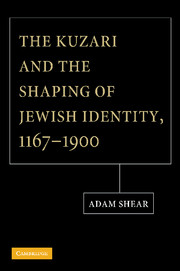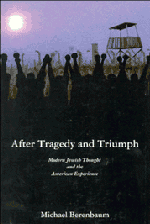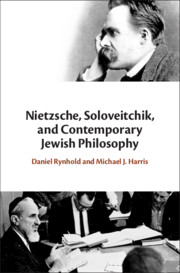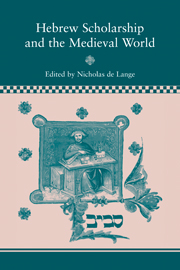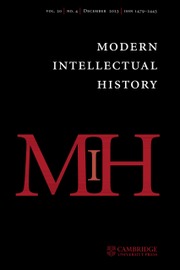The Kuzari and the Shaping of Jewish Identity, 1167–1900
$58.99 (C)
- Author: Adam Shear, University of Pittsburgh
- Date Published: July 2012
- availability: Available
- format: Paperback
- isbn: 9781107404991
$
58.99
(C)
Paperback
Other available formats:
Hardback
Looking for an examination copy?
This title is not currently available for examination. However, if you are interested in the title for your course we can consider offering an examination copy. To register your interest please contact [email protected] providing details of the course you are teaching.
-
Judah Halevi’s Book of the Kuzari is a defense of Judaism that has enjoyed an almost continuous transmission since its composition in the twelfth century. By surveying the activities of readers, commentators, copyists, and printers for more than 700 years, Adam Shear examines the ways that the Kuzari became a classic of Jewish thought. Today, the Kuzari is usually understood as the major statement of an anti-rationalist and ethnocentric approach to Judaism and is often contrasted with the rationalism and universalism of Maimonides’s Guide of the Perplexed. But this conception must be seen as a modern construction, and the reception history of the Kuzari demonstrates that many earlier readers of the work understood it as offering a way toward reconciling reason and faith and of negotiating between particularism and universalism.
Read more- First comprehensive exploration of this major medieval work
- First history in the English language of any work of medieval Jewish thought
- Demonstrates continuities in Jewish identity from Middle Ages to nineteenth century
Reviews & endorsements
"...high scientific quality...[Shear's] history of reception of Judah Halevi's Sefer ha-Kuzari is a wonderful journey through the centuries of Jewish culture in its various geographical and historical contexts. Adam Shear's study provides remarkable new insight into the history of Sefer ha-Kuzari and will be a fundamental work of reference for every future inquiry on Judah Halevi. --European Journal of Jewish Studies
See more reviews"Shear's work effectively shows how the life and vitality implicit in Halevi's argumentation and verbal artistry could generate a long afterlife for the _Kuzari_, which continues even today. Within the framework of its own subject matter, Shear's innovative study will likely stimulate renewed interest in the _Kuzari _among scholars and students of Jewish cultural and intellectual history as well a historians of Jewish philosophy and theology. ...Shear's multifaceted approach can and should serve as a model of what can be achieved, for an even wider audience of thoughtful and attentive readers." --H-Judaic (June, 2011)
"Adam Shear's study provides a remarkable new insight into the history of Sefer ha- Kuzari and will be a fundamental work of reference for every future inquiry on Judah Halevi. --European Journal of Jewish Studies
Customer reviews
Not yet reviewed
Be the first to review
Review was not posted due to profanity
×Product details
- Date Published: July 2012
- format: Paperback
- isbn: 9781107404991
- length: 402 pages
- dimensions: 229 x 152 x 23 mm
- weight: 0.59kg
- availability: Available
Table of Contents
Introduction
1. Texts and contexts: pre-modern dissemination and transmission
2. The image and function of the Kuzari in the Late Middle Ages
3. The Kuzari in Renaissance Italy
4. Judah Moscato's project and the making of an authoritative work
5. The image and function of the Kuzari in early modern Europe
6. The creation of an Enlightenment Kuzari
7. Continuity and change in the nineteenth century
Conclusion: the emergence of late modern dichotomies.
Sorry, this resource is locked
Please register or sign in to request access. If you are having problems accessing these resources please email [email protected]
Register Sign in» Proceed
You are now leaving the Cambridge University Press website. Your eBook purchase and download will be completed by our partner www.ebooks.com. Please see the permission section of the www.ebooks.com catalogue page for details of the print & copy limits on our eBooks.
Continue ×Are you sure you want to delete your account?
This cannot be undone.
Thank you for your feedback which will help us improve our service.
If you requested a response, we will make sure to get back to you shortly.
×
